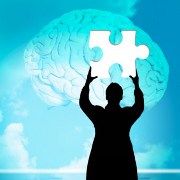 Via Unsplash
Via Unsplash
Lewy body dementia, also known as dementia with Lewy bodies, is a cortical type of dementia. It is the third most common type of progressive dementia after Alzheimer's disease and vascular dementia.
Dementia is a term used to describe a general decline in a person’s cognitive abilities, that is their thinking, memory, language, usually due to disease which results in degeneration of the brain. Lewy body disease is thought to be the second most common kind of dementia and is currently incurable.
"Cortical" refers to the cortex or grey matter which is the outer layer of the brain and plays a critical role in memory and language. People with cortical dementias usually have severe memory loss with associated problems affecting their ability to remember words or understand language.
Lewy body dementia shares characteristics with both Alzheimer's disease and Parkinson's disease. It is more common in older age, affecting around 20 percent of those with dementia worldwide.
Lewy body dementia is caused by the accumulation of abnormal microscopic protein deposits in the brain, which interrupt the brain's normal functions, causing it to slowly deteriorate.
Because Lewy body dementia symptoms closely resemble other diseases, it can be particularly difficult to diagnose correctly. This can create problems for the individual affected, as early diagnosis allows for key early treatment that can extend a person’s freedom and quality of life.
Individuals with Lewy body dementia lose cognitive function, which are those functions of the brain associated with language, memory, planning and attention. However they are less likely to have short-term memory loss which is associated with Alzheimer’s disease.
Lewy body dementia sufferers experience more problems with their executive function, which is their ability to be logical, flexible, or to make judgements or decisions to plan, organize and carry out usual day-to-day activities.
Their capacity to concentrate, to multitask, to be alert or react to changing circumstances are affected. So is their ability to cope with noisy environments.
Visual perception, such as judging distances or navigating one’s environment, is also impaired. This can result in regular falls or cause the individual to become lost in familiar settings.
Unlike Alzheimer’s disease, Lewy body dementia sufferers are able to make and retain new memories, recall long-term memories and relate to friends and family well into the late stage of their illness.
Their cognition fluctuates, though, leaving them to experience good and bad days. On good days, at least they are able to have insights and are fully capable of making choices available to them.
Lewy body dementia can take two forms. the first is Dementia with Lewy bodies as described above, the second is Parkinson’s disease dementia. The difference between them is dependent on how the disease begins.
In dementia with Lewy bodies, the individual may begin to show signs of memory disorder that are often mistaken as indications for Alzheimer's disease. However, the individual with Lewy body dementia later develops movement and spontaneous Parkinson’s-like motor symptoms.
Some of these symptoms are slowness of movement, hesitation in walking, rigid muscles, tremor, lack of facial expression, and abnormal gait. Recurrent visual hallucinations or delusions, of detailed shapes, colors, people, or animals is also a feature of the condition. Auditory hallucinations such as hearing knocking or footsteps are less common.
In Parkinson’s disease dementia, the person may initially have a movement disorder that looks like Parkinson's disease, but later the individual also develops dementia symptoms such as memory loss, personality changes and impaired intellectual functioning.
Lewy body dementia develops a range of difficulties that include variations in attention and alertness. It causes a progressive decline in mental abilities which causes people to experience recurrent visual hallucinations.
Other effects include symptoms such as a blank expression, rigid muscles, tremors, and slow movement which closely resemble Parkinson's disease.
Sleep disturbances including insomnia, daytime sleepiness are also signs and symptoms of Lewy body dementia. Rapid eye movement (REM) sleep disorder is a condition which is specific to Lewy body dementia, causes individuals to act out their dreams, sometimes violently.
Reviewed September 7, 2016
by Michele Blacksberg RN
Edited by Jody Smith
Dementia with Lewy Bodies Clinical Presentation. Medscape. Accessed August 5, 2016.
http://emedicine.medscape.com/article/1135041-clinical
What Lewy Body Disease Is. Lewy Body Journal. Accessed August 5, 2016.
http://www.lewybodyjournal.org/whatlbdis.html
Cognitive (Thinking) Changes in Lewy Body Disease. Helpsheet-LewyBodyDisease02-CognitiveChanges_english.pdf Accessed August 5 2016.
https://fightdementia.org.au
Dementia with Lewy Bodies. Alz.Org / Alzheimer’s association. Accessed August 5, 2016.
http://www.alz.org/dementia/dementia-with-lewy-bodies-symptoms.asp




Add a CommentComments
There are no comments yet. Be the first one and get the conversation started!